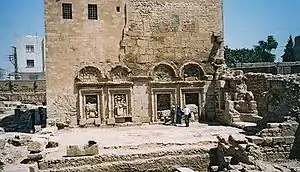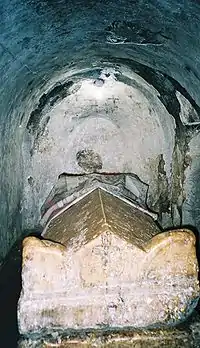Jacob of Nisibis
Saint Jacob of Nisibis (Syriac: ܝܥܩܘܒ ܢܨܝܒܢܝܐ, Yaʿqôḇ Nṣîḇnāyâ; Greek: Ἅγιος Ἰάκωβος Ἐπίσκοπος Μυγδονίας; Armenian: Յակոբ Մծբնայ, Yagop Mdzpnay), also known as Saint Jacob of Mygdonia,[6][note 1] Saint Jacob the Great,[7] and Saint James of Nisibis, was a hermit, a grazer and the Bishop of Nisibis until his death.[8]
Jacob of Nisibis | |
|---|---|
 Head reliquary of St. Jacob of Nisibis, Hildesheim | |
| Bishop of Nisibis | |
| Born | Nisibis, Roman Empire (modern-day Nusaybin, Mardin, Turkey) |
| Died | 337/338[1] or 350[2][3][4][5] Nisibis, Roman Empire (modern-day Nusaybin, Mardin, Turkey) |
| Venerated in | Church of the East Eastern Orthodox Church Oriental Orthodox Church Eastern Catholic Churches Roman Catholic Church |
| Major shrine | Church of Saint Jacob of Nisibis |
| Feast |
|
He was lauded as the "Moses of Mesopotamia", and was the spiritual father of the renowned writer and theologian Saint Ephrem the Syrian.[7] Saint Jacob was present at the first ecumenical council at Nicaea, and is venerated as a saint by the Church of the East, Eastern Orthodox Church, Oriental Orthodox Church, Roman Catholic Church, and Eastern Catholic Churches.
Biography

Saint Jacob was the son of prince Gefal,[3] and was born in the city of Nisibis in Mesopotamia in the 3rd century AD.[7] It is claimed that he was a relative of Saint Gregory the Illuminator.[7] Saint Jacob became a Confessor of the Faith for his suffering during persecution by Emperor Maximian.[7] Saint Jacob became an anchorite in c. 280 in the mountains near Nisibis where, according to Saint Theodoret of Cyrrhus, he survived on herbs and fruits, and chose to wear no clothes, build shelter, or light fires for warmth.[9] The saint became famous, and received visits from Sheria, Bishop of Arbela (r. 304–316), according to the Chronicle of Arbela.[10]
The saint resolved to climb Mount Qardu, traditionally believed to be the resting place of Noah's Ark, and recover a fragment of the ark upon hearing from the hermit Maroukeh that local people doubted the Great Flood.[11] Saint Jacob ascended the mountain and rested close to the summit; in his sleep, an angel placed a fragment of the ark close to him, and instructed him to awake.[11] The saint brought the relic to the hermit Maroukeh and, according to the saint's hagiography, a sacred spring appeared where the saint had rested, reputed to have healing properties.[11]
A number of miracles are credited to Saint Jacob by Saint Theodoret in Historia Religiosa (Religious History), in which the saint had a boulder explode beside a Persian judge who had given an unjust judgement.[12] Also, in one incident, Saint Jacob cursed boastful, promiscuous women by a spring so that their hair became white, and the spring disappeared.[13] The women subsequently repented, and the spring returned, however, the women's hair remained white.[13] As well as this, a group of people attempted to deceive the saint whereby they asked for money to fund the burial of a man they had lain down and covered with a sheet with the illusion of death; consequently, the man died, and the people repented and thus the man was resurrected as a result of Saint Jacob's prayers.[13]
Disagreement exists as to the date of the saint's consecration as bishop of Nisibis as it is argued it took place in c. 300,[9] and he is recorded as the city's first bishop by Saint Ephrem the Syrian.[14] However, Saint Jacob is credited as the successor of Babu, the first bishop of Nisibis (r. 300–309), by the Catholic Encyclopedia,[15] who Saint Ephrem states was in fact Saint Jacob's successor.[14] In his Chronography, Elijah of Nisibis states that Saint Jacob was consecrated bishop in 308.[10]
The Chronicle of Edessa states that the saint constructed the first church in Nisibis in c. 313–320.[1] Miles, Bishop of Susa, is said to have contributed a large quantity of silk from Adiabene to the church's construction.[7] The foundation of the School of Nisibis is also attributed to Saint Jacob.[13] Saint Jacob attended the First Council of Nicaea in 325, and opposed Arius.[1] Saint Ephrem purportedly accompanied the saint to the council, however, this is considered apocryphal.[16] Saint Jacob attended the funeral of Saint Metrophanes of Byzantium in 326.[6]
Saint Jacob was present at the siege of Nisibis by Shapur II, Shahanshah of Iran, in 337/338,[note 2] and according to Saint Theodoret, with encouragement from the city's population and Saint Ephrem, Saint Jacob ascended the walls and prayed for the city, and cursed the besiegers.[17] The Martyrologium Hieronymianum relates that he died on 15 July, the thirtieth day of the siege, according to the Chronicle of 724.[18] Gennadius and Saint Ephrem record that Saint Jacob was buried within the walls of Nisibis.[18] Saint Theodoret adds that the Iranian army was afflicted by a swarm of gnats and flies summoned by the saint, and Shapur II subsequently abandoned the siege.[17]
The saint is counted amongst the signatories of the Council of Antioch in 341,[4] however, his presence at the council is unrecorded in other sources.[7] In 350, according to the Chronicon Paschale, Saint Jacob helped defend Nisibis against Shapur II again, and as he was wearing the imperial regalia, was confused for Emperor Constantius II.[19] Shapur II challenged the saint to fight outside the city, where it was revealed he was an apparition and the Iranian army withdrew as a result.[19]
Relics

The Tomb of Saint Jacob of Nisibis located at the newly excavated Church of Saint Jacob of Nisibis.
The fragment of Noah's Ark discovered by Saint Jacob was later brought to Etchmiadzin Cathedral in Armenia.[11]
Saint Theodoret relates that the bones of Saint Jacob were transferred from Nisibis to Edessa following the city's cession to Iran on 22 August 363.[20][21] The saint's relics were later moved to Constantinople in 970,[22] according to the Menologion of the Armenians at Venice.
Fragments of the skull of Saint Jacob were donated to Hildesheim Cathedral in Germany in 1367 by Lippold von Steinberg after the Battle of Dinklar (de:Schlacht von Dinklar).[23]
In 2018, relics of Saint Jacob were brought from the Armenian Church of Saint George in Plovdiv, Bulgaria, to Canada, where they were taken to the Armenian Church of Saint Gregory the Illuminator in Montreal on 17 June, and the Armenian Church of the Holy Trinity in Toronto on 24 June.[24]
Works
Several homilies previously attributed to Saint Jacob by Gennadius of Massilia and others are now understood to be the work of Saint Aphraates.[1] The misidentification arose from Aphraates' assumption of the name Jacob upon becoming bishop.[25] Letters and canons, as well as other works, formerly attributed to the saint are known to be written in a later period.[1]
References
Notes
- Antiochia Mygdonia was a Seleucid colony in ancient Mesopotamia. In the classical Roman period it was known as Nisibis. Today it is the Turkish town of Nusaybin.
- From 337-350, Shapur II attacked Nisibis on three occasions, as it was the great city of Northern Mesopotamia and the bulwark of the eastern provinces:
- the first Siege of Nisibis took place in A.D. 338;
- the second in A.D. 346;
- and the third in A.D. 350, lasting three months.
Citations
- Bundy (2013), p. 602
- January 13/January 26. Orthodox Calendar (PRAVOSLAVIE.RU).
- St James the Bishop of Nisibis. Orthodox Church in America - Lives of the Saints.
- Rev. Sabine Baring-Gould (M.A.). "S. JAMES, B. OF NISIBIS. (CIRC. A.D. 350.)." In: The Lives of the Saints. Volume the Seventh: July - Part I. London: John C. Nimmo, 1898. pp. 351-357.
- Frend (1972), p. 8
- Great Synaxaristes: (in Greek) Ὁ Ἅγιος Ἰάκωβος Ἐπίσκοπος Μυγδονίας. 31 Οκτωβρίου. ΜΕΓΑΣ ΣΥΝΑΞΑΡΙΣΤΗΣ.
- Venables (1911)
- Jotischky, Andrew (2011). A hermit's cookbook: monks, food and fasting in the Middle Ages. London New York, NY: Continuum. ISBN 978-0-8264-2393-1.
- Hinson (1995), pp. 198-199
- Vööbus (1951), p. 28
- Our Patron Saint James of Nisibis. Armenian Apostolic Church
- Brown (1971), pp. 87-88
- St. James (Jacob) bishop of Nisibis, July 15. Syriac Orthodox Church of Antioch: Archdiocese of the Western U.S.
- Bundy (2000), p. 191
- Vailhé (1911)
- Mathews (2006), p. 162
- Lightfoot (1988), p. 124
- Burgess, pp. 8-9
- Whitby (1998), p. 196
- Harvey (2005), p. 124
- NISIBIS. Encyclopaedia Iranica
- Cross & Livingstone (2005), p. 861
- Kunstschätze erhalten. Bistum Hildesheim (in German)
- "Holy Relics of Sourb Hagop of Mtsbin (St. Jacob of Nisibis) in Montreal". Hayern Aysor. 21 June 2018. Retrieved 6 September 2018.
- Albert (1907)
Bibliography
- Albert, Francis X.E. (1907). "Aphraates". The Catholic Encyclopedia. New York: Robert Appleton Company.
- Brown, Peter (1971). "The Rise and Function of the Holy Man in Late Antiquity". The Journal of Roman Studies, Vol. 61. Society for the Promotion of Roman Studies. pp. 80–101.
- Bundy, David (2000). "Vision for the City: Nisibis in Ephrem's Hymns on Nicomedia". Religions of Late Antiquity in Practice. Princeton University Press. pp. 189–206.
- Bundy, David (2013). "Jacob of Nisibis". Encyclopedia of Early Christianity, ed. Everett Ferguson. Routledge. p. 602.
- Burgess, R. W. (1988). "The Dates of the First Siege of Nisibis and the Death of James of Nisibis". Byzantion, Vol. 69, No. 1. Peeters Publishers. pp. 7–17.
- Cross, Frank Leslie; Livingstone, Elizabeth A. (2005). The Oxford Dictionary of the Christian Church. Oxford University Press.
- Frend, W. H. C. (1972). "The Monks and the Survival of the East Roman Empire in the Fifth Century". Past & Present, No. 54. Oxford University Press. pp. 3–24.
- Harvey, Susan Ashbrook (2005). "Julian Saba and Early Christianity". Wilderness: Essays in Honour of Frances Young. A&C Black. pp. 120–134.
- Hinson, E. Glenn (1995). The Church Triumphant: A History of Christianity Up to 1300. Mercer University Press.
- Lightfoot, C. S. (1988). "Facts and Fiction: The Third Siege of Nisibis (A.D. 350)". Historia: Zeitschrift für Alte Geschichte, Bd. 37, H. 1. Franz Steiner Verlag. pp. 105–125.
- Mathews, Edward G. (2006). "A First Glance at the Armenian Prayers Attributed to Surb Eprem Xorin Asorwoy". Worship Traditions in Armenia and the Neighboring Christian East. St Vladimir's Seminary Press. pp. 161–175.
- Vailhé, Siméon (1911). "Nisibis". The Catholic Encyclopedia. New York: Robert Appleton Company.
 Venables, Edmund (1911). . In Wace, Henry; Piercy, William C. (eds.). Dictionary of Christian Biography and Literature to the End of the Sixth Century (3rd ed.). London: John Murray.
Venables, Edmund (1911). . In Wace, Henry; Piercy, William C. (eds.). Dictionary of Christian Biography and Literature to the End of the Sixth Century (3rd ed.). London: John Murray.- Vööbus, Arthur (1951). "The Origin of Monasticism in Mesopotamia". Church History, Vol. 20, No. 4. Cambridge University Press. pp. 27–37.
- Whitby, Michael (1998). "Deus Nobiscum: Christianity, Warfare and Morale in Late Antiquity". Bulletin of the Institute of Classical Studies. Supplement, No. 71. Wiley. pp. 191–208.